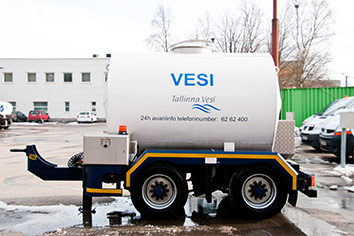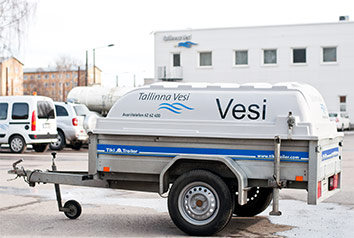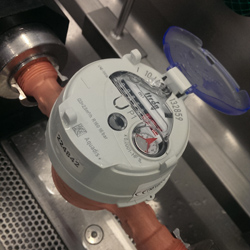Usage of water resource
Water extraction
Our activities in using water resources are regulated by the Water Act and its implementing provisions. As a water company we must hold a valid water extraction permit with a term and pay a fee for the water resource used. The water extraction permit involves certain obligations and restrictions (e.g. the permit sets out the allowed water extraction volume (m3)), keeping the account of water, metering ground water level, requirements of sampling standards, monitoring and analyses, also the allowed limit values of pollutants in effluent, requirements for monitoring the pollutants and the measures reducing the impact of water extraction).
All requirements established in the water extraction permits were met in 2014. The water extraction fee water is paid for the amount of water taken into Ülemiste Water Treatment Plant and for water pumped from ground water aquifers. In 2014, the water extraction fee amounted to 4.7% of the costs of the sold products/services.
Usage of surface water resources
To increase the water volume we have built a water catchment system, which consists of hydropoints constructed on rivers and of water reservoirs as well as the channels connecting those. Our water catchment system mainly comprises Harju sub-basin and the river basins of Soodla, Jägala and Pirita Rivers with the total area of ca 1,800 km2. The most important water reservoir is Lake Ülemiste with a net volume of 15.8 million m3 on a normal water level. Additional water reserves for dry periods have been accumulated to Paunküla water reservoir on the headwaters of the Pirita River (9.9 million m3) and to Soodla water reservoir on the Soodla River (7.4 million m3).
The volume of water resources in Tallinn’s surface water catchment system primarily depends on the annual amount of precipitation. In a year of average rainfall, approximately 50% of the possible water resources in the system are used up. Constant information on the flows enables us to use the water resource in the most efficient manner. To regulate the water resources in an optimum and accurate manner we have established water metering points at all hydropoints enabling us to meter both the flows conducted to the channels and the sanitary flows in the rivers. We perform metering regularly as per the requirements of the water extraction permit.
2014 was a dry year and thus additional water was taken to Lake Ülemiste almost throughout the entire year. More than half of the water need was covered by water from Pirita Ülemiste channel (14 million m3). 2006 was the last year, when such a high volume of water was additionally taken to the lake. Additionally, due to low precipitation the water washed considerably smaller amount of nutrients from soil into water bodies and this significantly improved the water quality in all water bodies. Single deviations clearly indicate the impact of human activity.
Pursuant to the water extraction permit L.VV/322982 (valid 01.04.2013-31.03.2018) the Company is allowed to extract 47.60 million m3 of surface water per year from Lake Ülemiste. The actual surface water use in 2014 was 22.61 million m3.
Usage of ground water resources
For the constant inspection of ground water resources in Tallinn and other operated areas, the Company carries out regular measurements of ground water levels. All bore-wells of the Company currently in use are equipped with automatic hydrostatic pressure sensors which enable to measure the static and dynamic level of ground water. The results of measuring the water levels in bore-wells indicate an increase in pressure level in the used aquifers, thus, the recovery of ground water resources.
Due to the transition from groundwater to surface water in Harku and Maardu and due to the increasing importance of surface water in Pirita area, the consumption of groundwater has declined slightly in 2014. The Company met all requirements established in the water extraction permits in 2014.
Leakages and interruptions to water supply
One of the most important objectives of water usage is the reduction of water losses in the network. The level of leakages has decreased compared to the last year.
The Service Agreement applied in the Tallinn service area sets us the commitment to reduce the level of leakages to 26%, on 2014 we managed to achieved 16.14%, which is an excellent performance. About ten years ago the level of leakages exceeded 32%, which means saving over 13 thousand m3 of water a day compared to the period ten years ago. Such a reduction in the level of leakages has been facilitated by our consistent efforts to use the water resource sustainably and with lower losses.
Detecting and eliminating the leakages as fast as possible contributes hugely to the reduction in the level of leakages. Our specialists have special equipment for finding leakages and along with zoning the network and remote reading devices it allows us to detect the leakages faster. In 2014, we purchased a new leak correlator to be able to detect leak locations more easily.
In order to mitigate the inconveniences resulting from an interruption to the service, we notified the customers in advance of unplanned interruptions in 95% of the events. In 2014 we started to use new Trimble water management system, which has made the process of leakage registration and keeping a record of works much more thorough and systematic.
In case of interruptions to water supply we provide customers with a temporary water supply with the water tanks. Small water tanks (1m3) can be delivered to an emergency site by a regular car and enable to offer temporary water supply to customers fast. In addition we use five large water tanks (5m³) and a truck carrying a water tank. In case house connections are closed, if necessary, temporary water connections to water metering points are constructed and temporary water supply is ensured with an air-water pressure tank. Since the beginning of 2014, we have been using a new insulated water tank to ensure a temporary water supply for customers also during cold winter period.
Veemõõtmine
The water meters we use are of high quality and comply with the European standard EN14154 as well as the accuracy requirements thereof. The expert studies and calibration of water meters is performed by the national Central Office of Metrology, AS Metrosert.
In total over 22,805 water meters have been installed to customers’ connection points, facilitating to achieve a more accurate accounting for the usage of water resources.
Thanks to the use of C-class water meters since 2005, the number of expert analyses ordered by customers for verifying the accuracy of the water meters has decreased. The number of expert analyses has consistently reduced over the recent years.
Pursuant to the Metrology Act we have the obligation to verify and replace the water meters every two years. In 2014, we replaced the total of 13,331 water meters based on a programme developed for that purpose. In 2015, we shall continue our work to make sure that all our customers have water meters verified on time.








